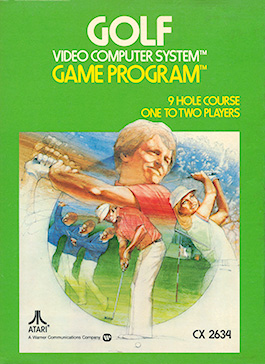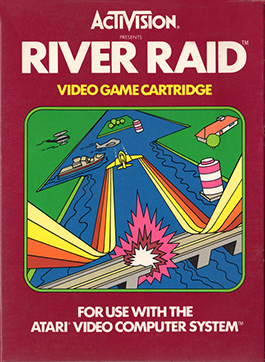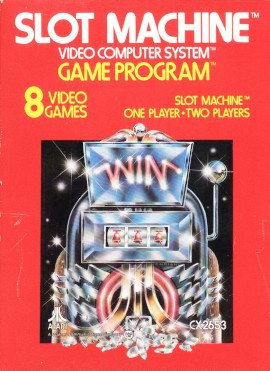
Steve Cartwright is an American video game designer. [1] He is best known as one of the original Activision game designers, credited with such games as Barnstorming , Megamania , Seaquest and Hacker . [2]

Steve Cartwright is an American video game designer. [1] He is best known as one of the original Activision game designers, credited with such games as Barnstorming , Megamania , Seaquest and Hacker . [2]
Prior to working at the company, Cartwright had gone to college with David Crane at the DeVry Institute of Technology in Phoenix. [3] [4] When Crane and Alan Miller created their own company Activision, they quickly found success in the video game business, leading them to hire new employees, which included Crane's friend Cartwright. [5]
At Activision, Cartwright designed games for the Atari 2600. These included Barnstorming (1982), Megamania (1982), Seaquest (1983), and Frostbite (1983). [6] In their book Racing the Beam , Ian Bogost and Nick Montfort stated that Cartwright's game design philosophy focused on iteration and refinement. [7] The authors described this style as This sort of technique would later come to be known as skinning. which they noted had negative connotations, "suggesting commercial exploitation without fundamental innovation." [8] while also stating that the design style "was not without its positive qualities. It involved the slow refinement of basic ideas toward perfection." [8]
He later developed games for the Commodore 64 with Hacker (1985), Hacker II (1986), Aliens (1986), and Gee Bee Air Rally (1987). [6]
Cartwright joined Accolade as their Senior Designer in 1988. He was in charge of developing new concepts in game design and organizing teams of designers and coordinating the creation and development of new games. [6]
Among his products were the Sierra-style graphic adventures Les Manley in: Search for the King and Les Manley in: Lost in L.A. —the first game to use live actors captured in front of a blue screen.[ citation needed ]
In 1993, Cartwright joined Electronic Arts. [9] He soon took over producer responsibility on the fledgling PGA Tour line and helped redesign the NBA Live product line. Among the many innovations to the golf line were the first use [2] of digitized golfers, the first EA golf product with 3D terrain, and the first use of a targeting arc and putting guides in a golf product.
In 1999, Cartwright designed and produced Tiger Woods '99 . Additionally, Cartwright designed the product to include 1-button access to a game server and match server—making this EA's first online multiplayer sports game. Later, with the addition of the "Play Against The Pros" feature, Cartwright was awarded co-patent holder rights to the technology that eventually became the basis of the PGA Tour Shotlink technology.[ citation needed ]
In 2002, Cartwright joined Scott Orr as an internal developer at Glu Mobile, originally known as Sorrent. After a 10-year hiatus from programming, Cartwright developed six of Sorrent's first eight products. During the 2004 presidential election, Cartwright took his previous product FOX Sports Boxing and turned it into Bush vs. Kerry Boxing . He was later named Director of Production where products he designed, produced, or otherwise developed accounted for up to 70% of Glu Mobile revenue.[ citation needed ]
In 2006, Cartwright joined TV Head—later known as TAG Networks—as Executive Producer. TAG was a games-on-demand television network.
In 2008, Cartwright spent several months developing and pursuing VC funding for a Kid's MMO in the vein of Club Penguin. This endeavor was abandoned when he joined Slipgate Ironworks The company later became Gazillion Entertainment.
In 2009, Cartwright joined former colleagues Adam Bellin and Sam Nelson in project design to make sports statistics fun and entertaining. The first project, Streakwise Draft Tracker 2011, reached #2 on the App Store.
In 2010, Cartwright joined RockYou as GM of the Redwood City Games Studio. In his first few weeks, he recruited John Yoo, lead designer on Zynga's CityVille , and helped RockYou establish a relationship with John Romero and his new company, Loot Drop. After managing through a difficult transition period following the layoff of nearly 1/3 of the company, Cartwright became Sr. Director of Design. He then worked closely with Executive Producer Jennifer Gee on the launch of RockYou's Zoo World 2 Facebook project. [10]
More recently, Cartwright lead the design of Bluescape's real-time cloud-based collaboration system. The Bluescape "wall" is currently being used by Lucasfilm to plan and storyboard future Star Wars films.

Kaboom! is an action video game published in 1981 by Activision for the Atari 2600. The gameplay was based on the Atari arcade game Avalanche (1978), with the game now involving a Mad Bomber who drops bombs instead of falling rocks. Kaboom! was programmed by Larry Kaplan with David Crane coding the graphics for the buckets and Mad Bomber. It was the last game designed by Kaplan for Activision, who left the company shortly after the release of the game. The game was later ported by Paul Wilson for the Atari 5200 system.
Alan Miller is an American video game designer who was the co-founder of the video game company Activision.

Pitfall! is a video game developed by David Crane for the Atari 2600 and released in 1982 by Activision. The player controls Pitfall Harry, who has a time limit of 20 minutes to seek treasure in a jungle. The game world is populated by enemies and hazards that variously cause the player to lose lives or points.

David Crane is an American video game designer and programmer. Crane grew up fascinated by technology and went to DeVry Institute of Technology. Following college, he went to Silicon Valley and got his first job at National Semiconductor. Through his friend Alan Miller he learned about potential video game design work at Atari, Inc. and began work there in 1977.

The TV Boy, and its successors TV Boy II and Super TV Boy, are handheld TV games sold by many different companies, including Systema, Akor, and NICS, based upon an unlicensed clone of Atari 2600 hardware. They were released around 1992 and three years later, an improved version of the TV Boy 2, the Super TV Boy, was also made by Akor. They were widely available across Europe. In the UK, they were most visibly available through Argos.

Golf is a 1980 video game programmed by Michael Lorenzen for Atari for the Atari 2600. It is based on the traditional sport of golf. The game allows one or two players to play nine holes of the game, featuring various obstacles.

River Raid is a video game developed by Carol Shaw for the Atari Video Computer System and released in 1982 by Activision. The player controls a fighter jet over the River of No Return in a raid behind enemy lines. The goal is to navigate the flight by destroying enemy tankers, helicopters, fuel depots and bridges without running out of fuel or crashing.
Scott Orr is an American video game designer best known as the lead designer on the first video game console versions of Madden NFL Football. In 2001, Wired magazine named Orr on its list of "gamemaking gods." Orr‘s career in sports games spans over 20 years.

Frostbite is a 1983 action game designed by Steve Cartwright for the Atari 2600, and published by Activision in 1983. The game has a player control Frostbite Bailey, who must hop across several ice floes to collect ice while avoiding falling in the water and avoiding the hazardous natural elements such polar bears and snow geese.

Megamania is a video game developed by Steve Cartwright and published by Activision in 1982. The game is a Fixed shooter, where a pilot of an intergalactic space cruiser who after eating a variety of food, has a nightmare where his ship is being attacked by food and house hold objects. Using the missile launcher from his space cruiser, he finds himself being attacked by various food items and house hold objects.

Intelligent Games Ltd was a British video game developer based in London. The company was established in 1988 as The Intelligent Games Co. by Matthew Stibbe, who was studying at Pembroke College in Oxford. Following his graduation and the releases of 'Nam 1965–1975 and Imperium, Stibbe relocated to London in 1992, where he incorporated Intelligent Games in 1993. He hired Imperium producer Kevin Shrapnell as director of development, who aimed for the company to develop "hit-driven, brand-led" games, among them a series of PGA Tour games and a tie-in to the film Waterworld. The latter attracted Westwood Studios, which worked with Intelligent Games on Dune 2000 and expansions for Command & Conquer: Red Alert. Relocating multiple times within London, Intelligent Games grew to 65 employees by 1999. That year, Westwood was unsuccessful in acquiring Intelligent Games but inspired Stibbe to want to leave the company. He sold it to Shrapnell, Cuss, and Neil Jones in June 2000 and departed that same year. Intelligent Games continued producing games, eventually eyeing the mobile and console markets, until running out of money in 2002. The company closed and all assets were liquidated in December 2002.
Michael Rexford Nicolette is an American professional golfer and inventor who played on the PGA Tour in the 1970s and 1980s.

Barnstorming is an Atari 2600 video game designed by Steve Cartwright and published by Activision in 1982. It was the first game designed by Cartwright. The idea for Barnstorming came to him as he watched a biplane one day while driving home from work.

Seaquest is an Atari 2600 video game designed by Steve Cartwright and published by Activision in 1983. The game is an underwater shooter in which the player controls a submarine.
Glyn Anderson has designed, programmed, and managed the production of video games starting with the Intellivision console. A musician as well as a programmer, he wrote the cross-platform sound and music driver used on many Activision games between 1989 and 1992, including Ghostbusters II and Lexi-Cross.

The first hobbyist-developed game for the Atari 2600 video game console was written in 1995, and more than 100 have been released since then. The majority of games are unlicensed clones of games for other platforms, and there are some also original games and ROM hacks. With only 128 bytes of RAM, no frame buffer, and the code and visuals closely intertwined, the 2600 is a difficult machine to program. and many games were written for the technical challenge. Emulators, programming tools, and documentation are available.

Parsons Xtreme Golf is a global sports equipment manufacturing company that designs, markets, and sells a line of custom fitted golf equipment products and accessories, mainly clubs. The company is based in Scottsdale, Arizona and was established in 2014 by Bob Parsons, founder of web hosting service GoDaddy.
Jack Nicklaus is a series of golf video games named after golfer Jack Nicklaus. The first game, Jack Nicklaus' Greatest 18 Holes of Major Championship Golf, was developed by Sculptured Software and published by Accolade. It was released for various platforms beginning in 1988. Accolade would publish subsequent games in the series for the next decade, before selling the rights to Activision in 1998. Activision published a sixth game in the series, Jack Nicklaus 6: Golden Bear Challenge, in 1999, but chose not to publish a sequel due to poor sales. The next game in the series, Jack Nicklaus Perfect Golf, was released by a new company in 2016.

Slot Machine is a 1979 video game written by David Crane for the Atari VCS and published by Atari, Inc. Along with Star Ship and Miniature Golf, it was one of the first Atari VCS games to be discontinued.